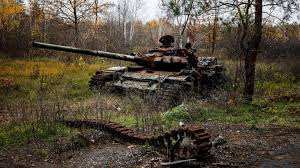Russia lost a lot of tanks in Ukraine last year. New ones and old ones. But since it can't replace the new ones, it is sending even more old ones.
The problem is that around Kyiv, Kharikiv and Kherson, Russia's old T-62 and T-55 tanks were annihilated. And that's all they have left. JL
David Axe reports in Forbes:
Russia’s winter offensive is grinding to a halt in the ruins of Bakhmut. Russian forces have lost at least 10,000 armored vehicles, trucks and howitzers that outside analysts can confirm. Desperate for replacements, the Kremlin is reactivating 1950s-vintage T-55s. When Ukrainian troops launched their first counteroffensive in eastern and southern Ukraine last fall, Russia's T-62s got massacred outside Kherson city. Ukraine's Leopard 2 will take out a T-62 or T-55 from any angle from more than a mile away in daytime or nighttime, even when the Leopard or its target is on the move. A T-55 with its older 100-millimeter gun and thinner armor must halt before firing.
When Russia’s initial offensive across southern, eastern and northern Ukraine faltered in the spring of 2022 and equipment losses deepened, the Kremlin reached deep into its reserve stocks and reactivated hundreds of obsolete, 1960s-vintage T-62 tanks.Flash forward a year. Russia’s winter offensive is grinding to a halt in the ruins of Bakhmut in eastern Ukraine’s Donbas region. Russian and allied forces have lost at least 10,000 armored vehicles, trucks and howitzers that outside analysts can confirm. Desperate for replacement tanks, the Kremlin is reactivating 1950s-vintage T-55s.
The parallels don’t end there. The Russians deployed many of the reactivated T-62s along the southern front, assigning them to reserve units holding defensive positions around occupied Kherson and Zaporizhzhia Oblasts. The T-55s apparently are deploying to the south, too.
One photo that circulated online in mid-April reportedly depicts a T-55 in Zaporizhzhia Oblast. A second, more recent photo depicts a T-55 on a heavy flatbed reportedly in the Russian-occupied Black Sea port of Berdyansk, also in Zaporizhzhia.
It’s unclear whether the T-55—and a T-62 apparently traveling in the same convoy—is arriving or departing the port. It’s possible the tanks arrived in Ukraine by rail, and were traveling to Berdyansk by truck to join the port’s Russian garrison. It’s also possible the tanks reached Ukraine by ship, and were heading north to equip units closer to the front.
Either way, the tanks’ ultimate fate should be the same. When Ukrainian troops launched their first major counteroffensive in eastern and southern Ukraine last fall, those T-62s the Russians rushed to southern Ukraine got massacred outside Kherson city.
The Ukrainians have captured or destroyed no fewer than 64 T-62s. There’s zero evidence of any of the 41-ton, four-crew T-62s—with their minimally-stabilized 115-millimeter guns, shoddy night-vision and 200-millimeter frontal armor—making any significant contribution to the Russian war effort.
There’s no reason to believe the 40-ton, four-crew T-55—with its even older 100-millimeter gun and thinner armor—will fare any better when Ukraine’s long-anticipated 2023 counteroffensive finally kicks off.
Especially considering that the Ukrainian armed forces in recent months have rearmed with scores of Leopard 2 and Challenger 2 tanks and hundreds of Stryker, M-2 and Marder fighting vehicles, all donated by Ukraine’s foreign allies.
The 25-millimeter autocannon that arms the M-2 can pierce a T-62 or T-55 from the side or back from hundreds of yards away. The 120-millimeter cannon that arms the 70-ton Leopard 2 will take out a T-62 or T-55 from any angle from more than a mile away in daytime or nighttime, even when the Leopard 2 or its target is on the move.
A T-55 meanwhile can’t even fight at night without turning on a turret-mounted infrared spotlight that instantly gives away its location. Its main gun lacks effective stabilization, meaning the tank must halt before firing.
The Russians haven’t yet lost any of their reactivated T-55s—at least, none that left behind any obvious photographic evidence. That’s likely to change, and soon, as more of the obsolete tanks arrive in southern Ukraine and take up defensive positions ahead of the coming Ukrainian counteroffensive.



















0 comments:
Post a Comment